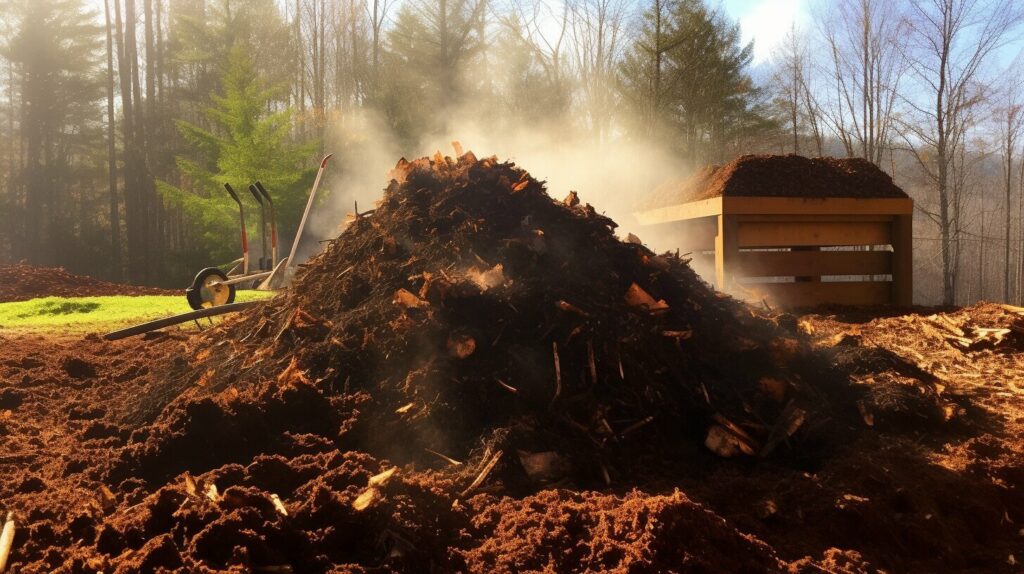Hot composting is a highly efficient process that allows for the rapid decomposition of organic waste, resulting in nutrient-rich compost. By maintaining specific temperatures, moisture levels, and a balance of nitrogen, carbon, and oxygen, hot composting promotes microbial activity and aerobic decomposition. Unlike cold composting, which takes longer, hot composting requires more attention and maintenance. However, the benefits are undeniable: it reduces waste in landfills, decreases the production of greenhouse gas methane, and provides a valuable soil enricher for gardens and plants.
- Hot composting is a fast and efficient method of composting organic waste.
- Specific temperatures between 49 °C and 71 °C are essential for optimal decomposition.
- The high temperatures in hot composting help kill weed seeds and harmful pathogens.
- Hot composting requires a balance of carbon-rich and nitrogen-rich materials.
- Regular monitoring and maintenance are necessary for successful hot composting.
And after reading this article, check out our blog post on: Different Types Of Compost To Enrich Your Soil
Understanding Hot Composting Fundamentals
Hot composting is a method of composting that utilizes heat to break down organic waste quickly. This process involves the activity of heat-loving microorganisms that thrive in elevated temperatures. To achieve optimal decomposition, the compost pile should reach temperatures between 49 °C and 71 °C. Monitoring the temperature using a compost thermometer is essential to ensure the right conditions for microbial activity.
The high temperatures in hot composting play a crucial role in killing weed seeds and harmful pathogens, resulting in nutrient-rich compost. This is why it is important to maintain the appropriate temperature range throughout the composting process.
To better understand the temperatures required for hot composting, refer to the table below:
| Temperature Range (°C) | Effect on Composting |
|---|---|
| Below 38 °C | Insufficient heat for rapid decomposition |
| 38 °C – 49 °C | Moderate decomposition, slower process |
| 49 °C – 71 °C | Optimal temperature range for hot composting |
| Above 71 °C | Too hot, can kill beneficial microorganisms |
By maintaining the right temperature and providing a suitable environment, hot composting allows for efficient decomposition of organic waste, resulting in nutrient-rich compost that can be used to enrich soil and promote healthy plant growth.
What Sets Hot Composting Apart
Hot composting stands out from other composting methods due to its unique characteristics and benefits. Let’s explore what sets hot composting apart.
A Faster and More Efficient Process
Hot composting offers a significant advantage in terms of speed and efficiency. Unlike traditional composting methods that may take several months or even years, hot composting can produce compost in a matter of weeks. The high temperatures generated during hot composting accelerate the decomposition process, resulting in rapid breakdown of organic waste.
By maintaining a temperature range of 49°C to 71°C, hot composting creates an ideal environment for heat-loving microorganisms to thrive. These microorganisms work efficiently to break down organic materials, resulting in nutrient-rich compost that can benefit your plants and garden.
Requires More Attention and Monitoring
While hot composting offers faster results, it also requires more attention and monitoring compared to other composting methods. To maintain the high temperatures necessary for decomposition, the compost pile needs to be regularly turned and aerated. This ensures proper heat distribution and encourages microbial activity.
Monitoring the compost temperature using a compost thermometer is crucial. It allows you to adjust the conditions if the temperature falls outside the optimal range. By actively managing the compost pile, you can speed up the decomposition process and ensure the quality of the resulting compost.
Promotes Efficient Aerobic Decomposition
Hot composting relies on aerobic decomposition, a process that occurs in the presence of oxygen. The high temperatures and regular turning of the compost pile create an oxygen-rich environment, which promotes efficient decomposition.
Aerobic decomposition not only breaks down organic waste quickly but also helps eliminate weed seeds and harmful pathogens. The intense heat generated during hot composting effectively kills these unwanted elements, ensuring a safer and more nutrient-rich compost for your garden.
Hot composting offers a faster and more efficient way to transform organic waste into valuable compost. While it requires more attention and monitoring, the benefits of hot composting make it a worthwhile method for any avid composter.
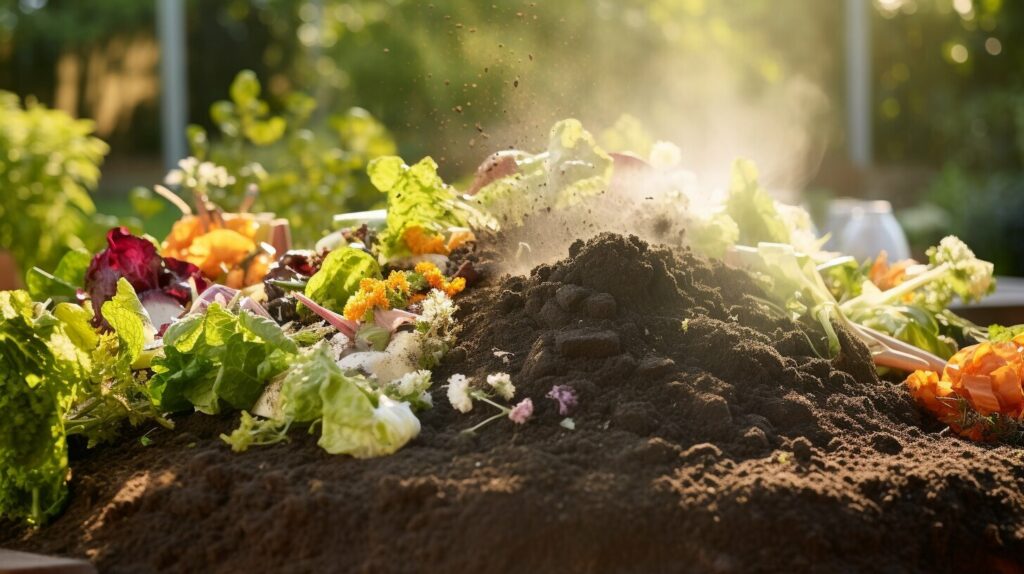
The Science Behind Hot Composting
Hot composting relies on the activity of heat-loving microorganisms that thrive in high temperatures. These microorganisms, such as bacteria and fungi, break down organic materials through aerobic decomposition. As they feed on the organic matter, they generate heat, raising the temperature of the compost pile. Maintaining the right balance of carbon and nitrogen, as well as proper moisture and aeration, creates an optimal environment for these microorganisms to thrive and decompose organic waste effectively.
In hot composting, the compost pile needs to reach temperatures between 49 °C and 71 °C to ensure optimal decomposition. Monitoring the temperature using a compost thermometer is crucial to assess the progress of the composting process. As the microorganisms break down the organic waste, they produce metabolic byproducts, including carbon dioxide and water vapor. These byproducts create heat, further increasing the temperature within the compost pile.
The aerobic decomposition in hot composting enables the microorganisms to efficiently break down the organic materials. Oxygen plays a vital role in this process, as it provides the necessary conditions for aerobic microorganisms to thrive. Proper aeration of the compost pile through regular turning or mixing helps supply oxygen and maintain the microbial activity needed for hot composting. Additionally, the high temperatures reached in hot composting help kill weed seeds and harmful pathogens, resulting in safer and nutrient-rich compost.
| Microorganisms | Activity |
|---|---|
| Bacteria | Breaks down simple organic compounds |
| Fungi | Breaks down cellulose and lignin |
| Actinomycetes | Aids decomposition and produces sweet earthy smell |
The science behind hot composting showcases the intricate relationship between microorganisms, temperature, and decomposition. By understanding these principles, gardeners can harness the power of hot composting to efficiently transform organic waste into nutrient-rich compost for their gardens and plants.
Ideal Materials for Hot Composting
When it comes to hot composting, choosing the right materials is crucial for successful decomposition. Here are some ideal materials you can use to create nutrient-rich compost:
- Carbon-rich ingredients: These materials provide the bulk and structure to the compost pile. They include dry leaves, straw, small twigs, shredded paper, and cardboard. These brown materials are a great source of carbon and help maintain heat and airflow in the compost pile.
- Nitrogen-rich ingredients: These materials are essential for providing the necessary nutrients for microbial activity and decomposition. Nitrogen-rich ingredients include fruit and vegetable scraps, coffee grounds, grass clippings, and animal manures. These green materials help speed up the decomposition process.
When adding materials to your hot compost pile, it is important to maintain a balance of approximately 2/3 brown materials to 1/3 green materials. This balance ensures optimal decomposition and prevents the compost from becoming too wet or smelly. Avoid adding animal products, fats, and materials treated with pesticides or herbicides, as they can disrupt the composting process.
| Carbon-rich Ingredients | Nitrogen-rich Ingredients |
|---|---|
| Dry leaves | Fruit and vegetable scraps |
| Straw | Coffee grounds |
| Small twigs | Grass clippings |
| Shredded paper | Animal manures |
| Cardboard |
Chopping the materials into smaller pieces can also help speed up the decomposition process and create a more uniform mixture in the compost pile. By using the right mix of carbon-rich and nitrogen-rich ingredients, you can ensure that your hot composting process is efficient and yields nutrient-rich compost for your garden.
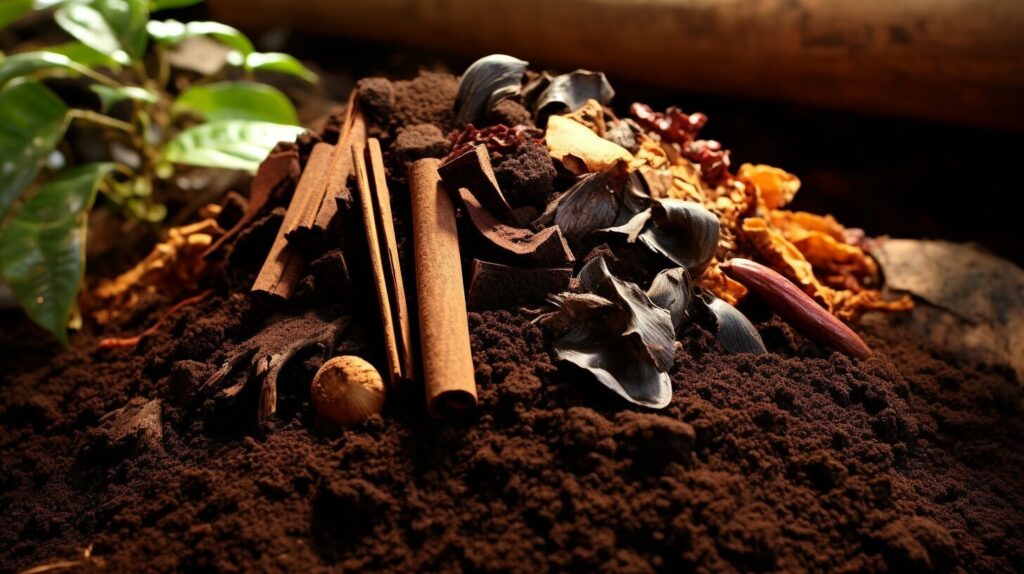
Balancing Carbon-Rich Ingredients
When it comes to hot composting, carbon-rich ingredients, also known as brown materials, are crucial for the success of the process. These materials provide the necessary structure and bulk to the compost pile, facilitating heat retention and airflow. It is important to have a good mix of different types of carbon-rich ingredients to prevent matting and ensure optimal decomposition.
Some examples of carbon-rich materials that can be used in hot composting include dry leaves, straw, small twigs, shredded paper, and cardboard. These ingredients not only contribute to the carbon content of the compost but also help create air pockets within the pile, promoting aerobic decomposition.
Chopping or shredding the carbon-rich materials before adding them to the compost pile can help speed up the decomposition process. Smaller pieces break down more quickly, providing more surface area for microorganisms to work on. It is advisable to aim for a particle size of around 1-2 inches for optimal results.
| Carbon-Rich Ingredients | Examples |
|---|---|
| Dry leaves | Fallen leaves from trees, leaf litter |
| Straw | Wheat straw, rice straw |
| Small twigs | Branches, small sticks |
| Shredded paper | Newspaper, office paper |
| Cardboard | Boxes, cereal boxes |
By ensuring a proper balance of carbon-rich ingredients in your hot composting process, you are providing the necessary foundation for microbial activity and efficient decomposition. Remember to monitor the temperature, moisture levels, and turn the compost pile regularly to maintain optimal conditions for hot composting.

Constructing the Foundation
Before starting hot composting, it is essential to create a strong foundation for your compost pile. Follow these steps to construct a solid base for optimal composting:
- Choose a suitable location: Find a shady area in your backyard or garden that is well-drained. Avoid placing the compost pile in direct sunlight, as excessive heat can disrupt the composting process.
- Clear the ground: Remove any grass, weeds, or debris from the chosen location. Use a garden rake or shovel to level the ground and create a flat surface.
- Install a compost bin or containment: Place a compost bin or wire containment structure on the cleared ground. This will help keep the compost materials contained and make it easier to turn the pile when necessary.
- Layer the base: Start by adding a layer of carbon-rich (brown) materials to the bin or containment. This can include dry leaves, small branches, dry lawn clippings, torn-up cardboard, or newspaper. Aim for a base layer depth of about six inches.
- Moisten the base layer: Lightly water the base layer to ensure it is moist but not waterlogged. This moisture will help kickstart the decomposition process by providing the necessary environment for microbial activity.
By constructing a solid foundation for your compost pile, you provide structure and facilitate proper airflow within the pile. This allows for efficient decomposition and helps maintain the necessary composting temperature. Remember to regularly turn the pile, add additional layers of composting materials, and monitor the moisture levels to ensure successful hot composting.
Composting Tips for Success
When practicing hot composting, there are several tips to keep in mind to ensure successful decomposition and maintain a healthy compost pile.
- Monitor compost temperature: Use a compost thermometer to regularly check the temperature of your compost pile. For hot composting, the optimal temperature range is between 49 °C and 71 °C. Adjust the pile accordingly by turning it more frequently or adding more green materials if the temperature drops.
- Maintain moisture levels: Proper moisture is essential for the breakdown of organic materials in hot composting. The compost pile should be moist, similar to a wrung-out sponge. If it becomes too dry, sprinkle water over the pile. On the other hand, if it becomes too wet, add more brown materials to absorb excess moisture.
- Aerate the pile: Regularly turning the compost pile helps maintain airflow and ensures even decomposition. Use a pitchfork or compost aerator to mix the materials thoroughly and introduce oxygen to the pile. Turning the pile every 1-2 weeks is recommended.
- Achieve the right carbon-nitrogen ratio: To maintain a healthy compost pile, it’s important to have a balanced carbon-nitrogen ratio. Aim for approximately 2/3 carbon-rich (brown) materials and 1/3 nitrogen-rich (green) materials. Adjust the ratio by adding more browns if the pile becomes too wet or more greens if it becomes too dry.
- Chop materials into smaller pieces: Breaking down the organic waste into smaller pieces helps speed up the decomposition process. Use a shredder, lawnmower, or sharp garden tools to chop leaves, twigs, and other materials into smaller sizes before adding them to the compost pile.
By following these tips, you can maintain the optimal conditions for hot composting and produce nutrient-rich compost more efficiently.
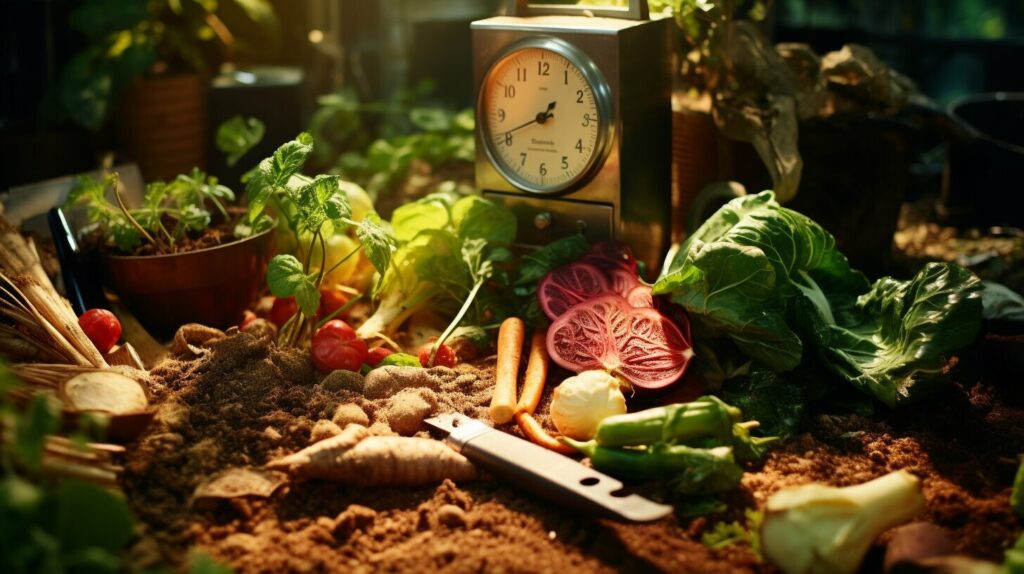
| Composting Tips | Description |
|---|---|
| Monitor compost temperature | Regularly check the temperature of the compost pile to ensure it stays within the optimal range of 49 °C to 71 °C. |
| Maintain moisture levels | Keep the compost pile moist, similar to a wrung-out sponge, by watering or adding more brown materials as needed. |
| Aerate the pile | Turn the compost pile every 1-2 weeks to maintain airflow and even decomposition. |
| Achieve the right carbon-nitrogen ratio | Strive for a balanced ratio of approximately 2/3 carbon-rich (brown) materials and 1/3 nitrogen-rich (green) materials. |
| Chop materials into smaller pieces | Break down organic waste into smaller sizes before adding them to the compost pile to speed up decomposition. |
Maximizing Composting Benefits
Hot composting offers numerous benefits for both the environment and gardeners. By utilizing this method, you can effectively manage organic waste and create nutrient-rich compost, contributing to a more sustainable and eco-friendly lifestyle.
One of the primary benefits of hot composting is the reduction of organic waste in landfills. Instead of letting food scraps and yard trimmings end up in the garbage, hot composting allows you to divert these materials into a productive process. As a result, you minimize landfill usage and reduce the production of harmful greenhouse gases like methane.
The compost produced through hot composting is a valuable soil amendment that enriches garden beds and promotes healthier plant growth. The nutrient-rich compost is packed with essential elements that nourish the soil and provide a steady supply of organic matter to plants. This enhances soil fertility, improves moisture retention, and encourages beneficial microbial activity, creating an ideal environment for plants to thrive.
Furthermore, hot composting allows you to actively participate in the circular economy. By recycling organic waste through composting, you close the loop by returning valuable nutrients back to the earth. This sustainable practice fosters a more self-sufficient and resourceful approach to gardening, reducing the need for synthetic fertilizers and supporting a healthier ecosystem.
| Benefits of Hot Composting |
|---|
| Reduces organic waste in landfills |
| Minimizes greenhouse gas emissions |
| Produces nutrient-rich compost |
| Enhances soil fertility and plant growth |
| Promotes a self-sufficient and resourceful gardening approach |
By embracing composting, you become an active steward of the environment, playing a significant role in waste reduction, soil health, and sustainable gardening practices. Start harnessing the benefits of hot composting today and experience the rewards it brings to both your garden and the planet.
Choosing the Right Composting Techniques
When practicing hot composting, there are several techniques to choose from, depending on your preference and available resources. Each technique offers its own advantages and considerations, allowing you to tailor your composting process to suit your specific needs. Here are some popular techniques:
1. Indore Method
The Indore method, also known as the traditional or classic method, involves layering green and brown materials to create a compost pile. Start with a layer of carbon-rich brown materials at the bottom, followed by a layer of nitrogen-rich green materials. Repeat this layering process until the compost pile reaches the desired size. Turning the pile every few weeks helps maintain heat and accelerate decomposition. This method is suitable for small to medium-scale composting and works well for gardeners with access to a variety of composting materials.
2. Berkeley Method
The Berkeley method, also known as the fast or hot method, is a more intensive technique that requires regular monitoring and turning of the compost pile. The key to this method is achieving and maintaining high internal temperatures to speed up the decomposition process. To achieve this, the compost pile needs to be built in layers, with careful attention to the carbon-to-nitrogen ratio and moisture levels. The pile needs to be turned every few days to aerate and distribute heat evenly. This method is ideal for those who want to produce compost quickly and have the time and dedication to actively manage the composting process.
3. Trench Composting
Trench composting involves digging a trench in your garden or composting area and filling it with alternating layers of green and brown materials. The trench should be around one foot deep and wide. As you fill the trench, cover the materials with soil, allowing them to decompose naturally. This technique is convenient for gardeners with limited space or those who prefer to compost directly in their garden beds. It is also suitable for composting larger quantities of organic waste.
4. Vermicomposting
Vermicomposting utilizes worms to break down organic waste. Worms, typically red wigglers, are added to a bin or container along with bedding materials such as shredded newspaper or cardboard. The worms consume the organic matter and produce vermicompost, a nutrient-rich material. This method is suitable for those living in apartments or urban areas with limited outdoor space. It is also an effective way to compost kitchen scraps quickly and efficiently.
5. Compost Tumblers
Compost tumblers are enclosed containers that can be rotated or turned manually, providing an easy way to aerate and mix compost materials. They are particularly useful for those with limited physical mobility or space constraints. Compost tumblers can accelerate the hot composting process by ensuring consistent aeration and mixing. They are available in various sizes to accommodate different composting needs.
Choosing the right composting technique depends on factors such as available space, time commitment, and the amount and type of organic waste you generate. Consider your specific circumstances and goals when selecting a composting method. Remember to monitor the composting process regularly and make adjustments as needed to ensure successful decomposition and the production of high-quality compost.
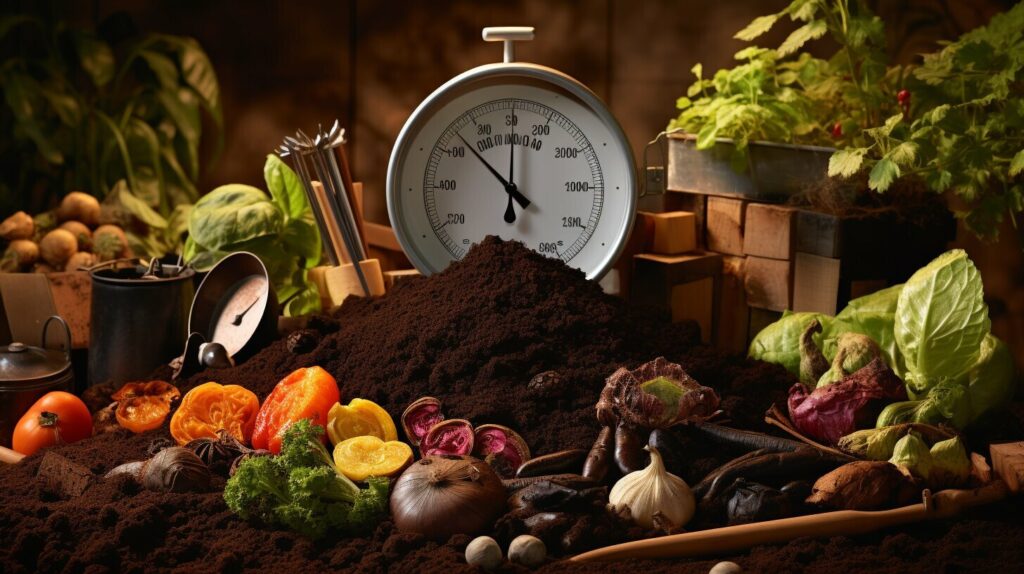
Conclusion
Hot composting is a highly efficient method for transforming organic waste into nutrient-rich compost. By maintaining the right temperature, moisture levels, and encouraging microbial activity, hot composting can produce compost in just a few weeks. The high temperatures reached during the process also help eliminate weed seeds and harmful pathogens, making the resulting compost safe for use in gardens and plant beds.
Practicing this type of composting, not only helps reduce waste but also contributes to sustainable gardening practices. By diverting organic waste from landfills and reducing the production of greenhouse gas methane, hot composting plays a valuable role in environmental conservation. The nutrient-rich compost produced can be used to enrich the soil, improve plant growth, and promote overall garden health.
By embracing this composting technique, we can actively participate in the creation of a greener future. The benefits of this composting process extend beyond my own garden, as they positively impact the environment by reducing waste and supporting sustainable practices. Through hot composting, I can transform organic waste into a valuable resource for nourishing my plants, creating a healthier ecosystem, and contributing to a more sustainable world.
FAQ
What is hot composting?
Hot composting is a process that involves the rapid decomposition of organic waste to produce nutrient-rich compost. It requires specific temperatures, moisture levels, and a balance between nitrogen, carbon, and oxygen.
How does hot composting differ from other composting methods?
Hot composting breaks down organic waste more quickly due to the high temperatures reached in the compost pile. It requires more attention and maintenance, but results in compost being produced in weeks to months, compared to traditional methods which can take longer.
What are the benefits of hot composting?
Hot composting helps reduce waste in landfills, decreases the production of greenhouse gas methane, and provides a valuable soil enricher for gardens and plants.
What temperature should a hot compost pile reach?
The compost pile should reach temperatures between 49 °C and 71 °C for optimal decomposition. Monitoring the temperature using a compost thermometer is essential.
What materials are suitable for hot composting?
Carbon-rich (brown) materials such as dry leaves, straw, small twigs, shredded paper, and cardboard, as well as nitrogen-rich (green) materials like fruit and vegetable scraps, coffee grounds, grass clippings, and animal manures, are suitable for hot composting.
How do I construct a foundation for hot composting?
Choose a shady, well-drained area in your backyard or garden. Clear the ground and place a compost bin or wire containment to hold the materials. Layer a base of brown materials, such as leaves, small branches, dry lawn clippings, newspaper, or torn-up cardboard, to a depth of six inches. Lightly water the base to ensure moisture is present.
What should I avoid adding to a hot compost pile?
Avoid adding animal products, fats, and materials treated with pesticides or herbicides to a hot compost pile.
What are some tips for successful hot composting?
Tips for successful hot composting include maintaining the right balance of carbon and nitrogen, turning the pile regularly to maintain heat and microbial activity, and ensuring proper moisture and aeration.
How long does hot composting take?
With proper temperature, moisture, and aeration, hot composting can produce compost in a matter of weeks.
How can hot composting benefit my garden?
Hot composting provides nutrient-rich compost that improves soil fertility, promotes plant growth, and helps suppress diseases and pests.
What composting techniques can I choose from for hot composting?
Some popular techniques for hot composting include the three-bin system, the Berkeley method, and the Johnson-Su bioreactor method.

